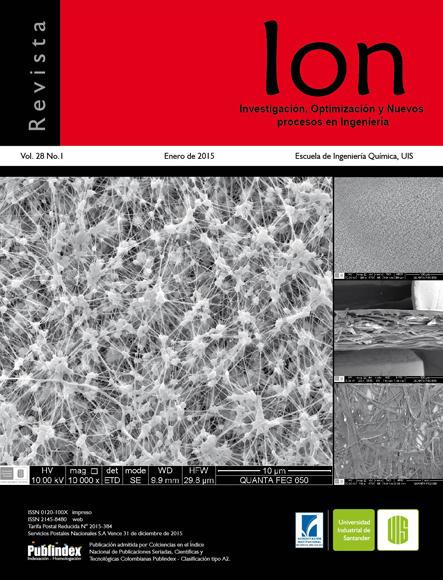Effect of thermal treatment on content of amino acids of two clones of banana flours
Published 2015-07-17
Keywords
- Banana,
- Flour,
- Aminoacid Balance,
- Amino Acids.
How to Cite
Abstract
The goal of the researching was to measure the effect of heat treatment on the crude protein content and total amino acids profile in cooked banana flours elaborated from bananas of the cultivars (Musa AAB, cv joint sub group Hartón common, and dwarf). The edible portion from the two bananas cultivars with and without thermal pre-treatment was dehydrated by using the oven conventional procedure. The flours obtained were analyzed in their content of moisture, crude protein, amino acid profile, amino acid balance, and aw. The results indicate an increase in the moisture content and water activity of the thermally treated flour prior to dehydration. However, their levels are adequate to permit long shelf life. Hartón common banana flour contains higher concentrations of amino acids than those obtained for flour obtained from the Hartón dwarf. The amino acids predominantly present in both flours were glutamic acid, aspartic acid, lysine, alanine, arginine and leucine. The total amino acid composition and aminoacidic balance were decreased in the flours by effect of the thermal treatment prior to dehydration, being the tryptophan, the main limiting amino acid in all of the analyzed flours. From the data obtained in the study, it is suggested the enrichment of these flours with protein with high biological quality when proposing for food uses.
Downloads
References
[2] Lescot T. La diversité génétique des bananiers en chiffres. Les dossiers de fruitrop. 2008;155:29-33.
[3] FAOSTAT. Disponible en: http://faostat3.fao.org/browse/Q/QC/S. Acceso el 14 de enero de 2015.
[4] INN. Instituto Nacional de Nutrición. Tabla de Composición para uso práctico. Pub. 52. Serie de Cuadernos Azules. Ministerio de Sanidad y Asistencia Social. Instituto Nacional de Nutrición. Dirección Técnico División de Investigación en Alimentos, Caracas Venezuela. 1999.
[5] Hernández JB, Cañizares Chacín AE, Blanco G, Arrieche I, Pérez A , Salazar C, González M. Contenido de nitrógeno, fósforo y potasio en harinas de clones de musáceas comestibles (Musa spp.). Revista UDO Agrícola. 2009;9(2):449-57.
[6] Dzomeku B, Adu-Kwarteng E, Darkey S. Comparative study on the nutritional composition of two FHIA tetraploids FHIA-21 (tetraploid French plantain) and FHIA-03 (tetraploid cooking banana) in Ghana. Am. J Food Technol. 2007;2(5):452-6.
[7] Heslop-Harrison J, Trude S. Domestication, genomics and the future for banana. Anna Bot. 2007;100:1073–84.
[8] Pillay M, Ogundiwin E, Tenkouano A, Dolezel J. Ploidy and genome composition of Musa germplasm at the International Institute of Tropical Agriculture (IITA). Afri. J. of Biotech. 2006;5:1224-32.
[9] Martínez G, Manzanilla E, Pargas R, Marín C. Respuesta del peso de racimo y otros componentes del rendimiento del plátano “hartón enano” (Musa AAB) sometido a tres densidades de siembra. Memorias XV Congreso de la Asociación de Bananeros de Colombia. Cartagena de Indias, Colombia. Colombia: 2002. p.408-11.
[10] Pacheco E. Evaluación nutricional de sopas deshidratadas a base de harina de plátano verde. Digestibilidad in vitro de almidón. Acta Cient. Venezolana. 2001;52:278-82.
[11] Pacheco E, Maldonado R, Pérez E, Schroeder M. Producción y caracterización de harinas de plátano (Musa paradisiaca L.) inmaduro. Interciencia. 2008;33:290-6.
[12] Sharaf A, Sharaf DA, Hegazi SM, Sedky K. Chemical and biological studies on banana fruits. Zeitschrift für Ernahrungwissenschaft. 1979;18:8-15.
[13] Ly J. Bananas y plátanos para alimentar cerdos: aspectos de la composición química de las frutas y de su palatabilidad. Rev. Comp. Prod. Porc. 2004;11(3):5-25.
[14] Menezes D. Evacuação das propriedades físicas, reológicas e químicas durante o amadurecimento da banana “prata-ana” (tesis doctoral). Brasil: Universidad Federal de Viscosa; 2006.
[15] Von Loesecke H. Bananas (2º ed.) New York: Interscience. 1950.
[16] AACC. American Association of Cereal Chemists. Approved Methods. Edition 10th. CPL Scientific Publishing; 2003.
[17] Richard J, Labuza TP. Rapid determination of the water activity of some reference solutions, culture media and cheese using a new dew point apparatus. Sci. Aliments. 1990;10:57-62.
[18] Gorinstein S, Pawelzik E, Delgado E, Haruenkit R, Weiszy W, Trakhtenberg S. Characterization of pseudocereal and cereal proteins by protein and amino acid analyses. J. Sci. Food Agric. 2002;82:886-91.
[19] Muyonga JH, Ramteke RS, Eipeson WE. Pre-dehydration steaming changes physicochemical properties of unripe banana flour. J Food Process. Preserv. 2001;25:35-47.
[20] Nielsen, S. Food Analysis. Tercera edición. Nueva York: Kuwer academic-Plenum publishers; 2003. p.257.
[21] Yang C, Fujita S, Ashrafuzzaman M, Nakamura N, Hayashi N. Purification and characterization of polyphenol oxidase from banana (Musa sapientum L.) pulp. J. Agric. Food Chem. 2000;48:2732-5.
[22] Martinez Navarrete N, Andres Grau AM, Chiralt Boix A, Fito Maupoey P. Capitulo 3, Concepto de Actividad de agua En: Termodinámica y cinética de sistemas: alimento entorno. Ed. Universidad Politécnica de Valencia; 1998. p. 60.
[23] Tortoe C, Johnson P, Nyarko A. Effects of osmo-dehydration, blanching and semi-ripening on the viscoelastic, water activity and colorimetry properties of flour from three cultivars of plantain (Musa AAB). Innov. Food Sci. Emerg. Technol. 2009;10:82–6.
[24] Ketiku AO. Chemical composition of unripe (green) and ripe plantain (Musa paradisiaca). J. Sci. Food Agric.1973;24(6):703-7.
[25] Gwanfogbe P, Cherry J, Simmons J, James C. Functionality and nutritive value of composite plantain (Musa paradisiaca) fruit and glandless cottonseed flours. Trop. Sci. 1988;28(1):51-66.
[26] Barthakur N, Arnold N. Chemical evaluation of Musa “Bhimkol” as a baby food. J. Sci. Food Agric. 1991;53(4):497-504.
[27] FAO/OMS. Protein quality evaluation. Rome, Italy: Food and Agriculture Organization of the United Nations; 1991. p. 66.
[28] Prachayawarakorn S, Tia W, Plyto N, Soponronnarit S. Drying kinetics and quality attributes of low-fat banana slices dried at high temperature. Journal of Food Engineering. 2008;85:509–517.
[29] Muyonga J, Ramteke R, Eipeson W.E. Predehydration steaming changes physicoceiemical properties of unripe banana flour. Journal of Food Processing and Preservation. 2001;25:35-47.

